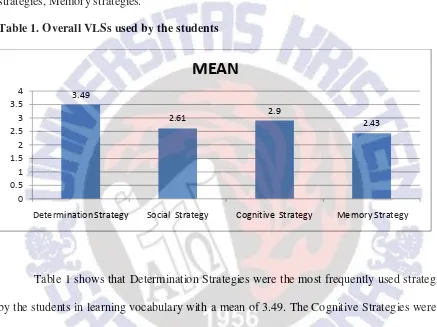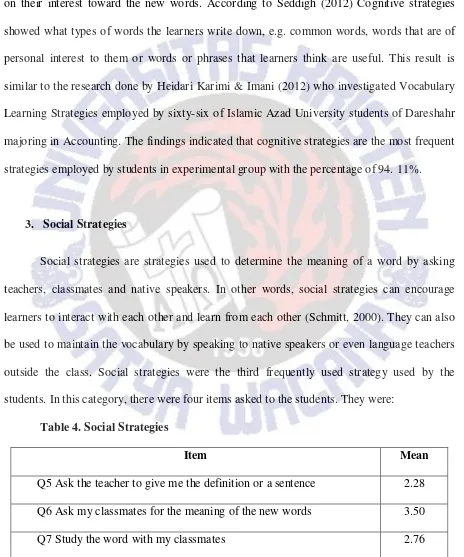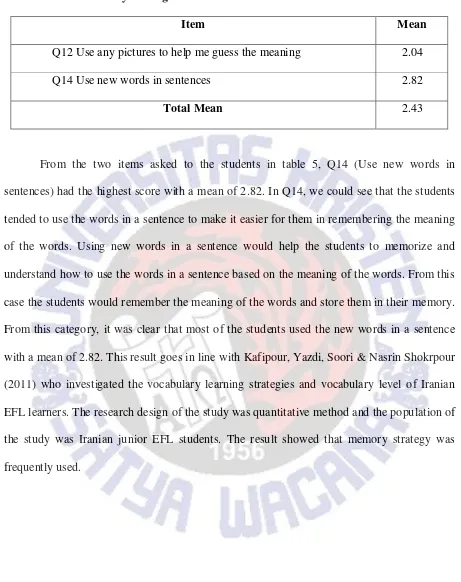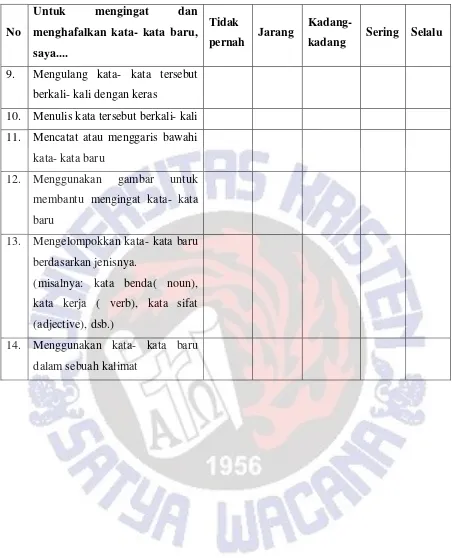1
SATYA WACANA CHRISTIAN UNIVERSITY MATH SCIENCE
STUDENTS’ STRATEGIES IN LEARNING VOCABULARY
Yustian Handoko
Abstract
Vocabulary is the main part in learning English. Learning vocabulary is very difficult especially for English for Specific Purposes (ESP) students. There are many strategies in learning vocabulary. This study aimed to describe the vocabulary learning strategies (VLSs) among Math Science students at Satya Wacana Christian University in Salatiga. They learn English vocabulary just related to Math. A questionnaire was the instrument for the data collection in this research. The participants were 76 male and female students who had taken Math English in second semester of 2012 academic year. The data were collected using questionnaire. The results revealed that Determination strategies were the most frequently used VLS and Memory strategies were the least used.
Keywords: Vocabulary learning strategies (VLS), ESP, Math Science
Introduction Background of the Study
Learning English as a foreign language is not easy for students to learn. There are many things that the students have to acquire especially in learning and acquiring vocabulary. Some vocabularies may be difficult to be learned for the students especially for English as a Foreign Language (EFL). According to Seddigh & Shokrpur (2012) vocabulary is inevitably a part of any language system and vocabulary knowledge has a significant role in language comprehension and production. Consequently, VLS are important in language learning strategies and both teachers and learners should be aware of their uses. The success of the students depends on how far the students acquire vocabulary.
2
math and science terms. Monroe & Orme (2002) said that the development of mathematical vocabulary cannot be ignored. Students must have adequate opportunities to learn this vocabulary in meaningful ways. Learners need experiences with constructing meaning from context as well as from direct teaching. The students have to pay attention to the vocabulary and find out the most appropriate strategies to increase their vocabulary.
The vocabularies used by the students in Math and Science class are related to Math. There are many strategies they can use to improve their vocabulary. The students study English related to math terms, so vocabularies in this class are more specific. This study focused on the strategies used by the Math Science students in learning vocabulary. The question of the study was, “What are the strategies used by math science students in learning vocabulary?” The purpose of this research was to describe the strategies used in learning vocabulary.
It was expected that the findings obtained from this study may be useful and serve a guide for both teachers and learners. The outcome can be beneficial in assisting students to apply appropriate vocabulary learning strategies in their specific field of learning. Additionally, it enables teachers to develop more effective teaching materials in order to assist students to efficiently improve their vocabulary.
Literature Review
3
to communicate about our thought. Schmitt (2007) also argued that ESP learners should focus on a specific field of study, e.g., Students of medicine will need to learn the technical vocabulary required in that field.
Vocabulary learning strategies is crucial part in learning language. There are many strategies in learning vocabulary. Vocabulary learning strategies are way for the students to make learning vocabulary easier. According to Kafipour & Naveh (2011) vocabulary learning strategies are a subdivision of language learning strategies which have attracted much attention since the late Seventies. VLSs are special instructional tools and ways of going about directly or explicitly as well as the independent word learning skills required to learn words independently. The other definition of vocabulary learning strategies was proposed by Seddigh & Shokrpura (2012). They define VLSs as an integral part of any language system and vocabulary knowledge has a significant role in language comprehension and production. Vocabulary learning strategies are a part of language learning strategies which is a part of general learning strategies. Any techniques or tools which can be used to learn vocabularies quickly, easily and independently are called vocabulary learning strategy (Kafipour, Yazdi, Soori & Shokrpour, 2011). According to Wang (2012), vocabulary learning strategies refer to both the general approaches and specific actions adopted by a learner to facilitate vocabulary learning. Asgari & Mustapha (2011) defined vocabulary learning strategies (VLSs) as steps taken by the language learners to acquire new English word. VLSs are a subcategory of language learning strategies particularly effective in language (Seddigh & Shokrpour, 2013).
4
excellent predictor of their ability to understand science text. In addition, prior knowledge and building background knowledge facilitates students’ comprehension of science text, vocabulary, and key concepts (Young, 2005). To help the students improve their vocabulary, some strategies are needed. According to Monroe & Orme (2002) an important component in language learning is learning vocabulary. Vocabulary cannot be ignored in learning language. Based on Monroe and Orme’s statement, it can be said that vocabulary is an important part in learning a language. The knowledge of vocabulary is an essential part when using a second or foreign language due to the fact that one is unable to communicate with others without a sufficient amount of words (Al- Khasawneh, 2012). Lack of vocabulary can cause a problem for the students in communication especially for math science students when they have to communicate math ideas in English.
5
2012). According to Chen & Li (2010) Language used to define mathematical concepts and express mathematical ideas, plays a key role in mathematics learning and teaching.
Types of Vocabulary learning strategies
Learning vocabulary is very important in learning a language. Each student must have their own strategies in learning vocabulary. There are many strategies that they can use in learning vocabulary. Research shows that many learners do use strategies for learning vocabulary, and some of the more common strategies are simple memorization, repetition, and taking notes on vocabulary (Schmitt, 2007). Kafipour & Naveh (2011) cited Schmitt (2000) taxonomy who proposed taxonomy of vocabulary learning strategies. the classification presented by Schmitt (2000) is the basis for the current study. According to this classification, strategies are classified as Determination, Social, Memory, Cognitive, and Metacognitive.
• Determination strategies are strategies that help learners to determine the meaning
by using dictionaries, guessing the meaning from the context and identifying the parts of speech and constituent elements. In other words, determination strategies are individual learning strategies that help learners to identify the meaning of new words without the other’s help.
• Social strategies are strategies used to determine the word definitions by asking
6
• Memory strategies are a large number of strategies that learners apply to recall the
vocabulary. In other words, Memory strategies help learners to acquire the new words via mental processing by connecting their background knowledge to the new words. As an example, when the learner encounters the word “dog”, he groups the word “dog” under the category of a four-legged animal since the learner is aware of the image of these four-legged animals from its background knowledge. Memory strategies are composed of three groups: a) using images to create a strong connection with the word and its meaning. These images can be shaped in the mind or drawn in notebooks, b) using strategies to link words together to help retrieval of vocabulary. For example, using words in the sentences make retrieval easier, and c) using vocabulary knowledge aspects to stabilize the meaning of the words. Specific examples include giving attention to the word’s phonological or orthographical form, memorizing affixes and roots, matching some words to their corresponding physical action, and learning the word class. • Cognitive strategies deal with mechanical aspects of learning vocabulary and are
not related to mental processing. Repetition is one of the most commonly used cognitive strategies. Other examples are taking notes and highlighting new words, making lists of new words, using flashcards to record new words, putting English labels on physical objects, keeping a vocabulary notebook, and writing the words many times.
• Metacognitive Strategies mirror learners’ capability to find opportunities to learn
7
studying new words many times, paying attention to English words when someone is speaking English, studying new words many times, and skipping or passing new words.
8
memory strategy was the most frequently used by the students with a mean of 3.01. Also, another finding done by Alhaysony (2012) studied about the Saudi Arabian students at the University of Ha’il. A sample of 746 male and female students participated in the study. The data collection was carried out through a questionnaire. The result showed that social strategies were popular among the Saudi EFL students with a frequency rating of 2.99.
9
The Study
Context of the Study
The method used in the research was descriptive. The purpose of the research was to describe vocabulary learning strategies used by the Math Science students. The setting was the Math Faculty of Satya Wacana Christian University.
Participants
Seventy six male and female students of Math Science students of Satya Wacana Christian University were the participants of the study. The students who had taken Math English in second semester of 2012 academic year students participated in this research. The students learned English for specific purposes related to Math course.
Research Instrument
The purpose of the research was to describe vocabulary learning strategies used by Math Science students in Satya Wacana Christian University. In this study a questionnaire was used to collect the data. The questionnaire used vocabulary learning strategies questionnaire (VLSQ) as in the study by Kafipour & Naveh (2011). It had 14 items using a likert-scale with four options: “tidak pernah” (Never) (1) up to “selalu” (always) (4). The questionnaire was divided in four categories: Determination strategies, social strategies, cognitive strategies and memory strategies. The questionnaire was given to the students who were taking math
English course.
10
was tried out with three students to check whether the questions in the questionnaire were understandable.
Data collection Procedure
The questionnaire was given at the end of the class. First, the questionnaire was distributed to the students. Next, the researcher explained the instructions. The questionnaire was given to 76 participants. The time given would be approximately 15-20 minutes for the participants.
Data Analysis procedure
11
Finding and Discussion
The aim of this paper was to describe vocabulary learning strategies used by Math students at Satya Wacana Christian University. The finding showed the descriptive statistics of the vocabulary learning strategies employed by the students. There were four categories of vocabulary learning strategies. Determination strategies, Social Strategies, Cognitive strategies, Memory strategies.
Table 1. Overall VLSs used by the students
Table 1 shows that Determination Strategies were the most frequently used strategies by the students in learning vocabulary with a mean of 3.49. The Cognitive Strategies were in the second place with a mean of 2.90. The Social Strategies with a mean of 2.61 were in the third place. The Memory Strategies were the least frequently used strategies by the students compared to other strategies with a mean of 2.43. From table 1 above, it was clear that Determination strategies were the strategies used most frequently by the students. This strategy may be the easiest strategy because when the students found difficulties to find out the meaning of new words they looked up the dictionary. Then the Memory strategy was the least frequently used by the students with a mean of 2.43. In other words Memory Strategies were the last popular strategy employed by the students.
3.49
Determination Strategy Social Strategy Cognitive Strategy Memory Strategy
12
The sections below present each category in which there were four categories provided. The category was described from the most to the least frequently strategies used by the students in learning vocabulary.
1. Determination Strategies
Determination Strategies were the strategy used most often by the students in learning vocabulary. Determination strategies helped the learners to determine the meaning by using dictionaries, guessing the meaning from the context and identifying the parts of speech. In other words, determination strategies are individual learning strategies that help learners to identify the meaning of new words without the other’s help (Schmitt, 2000). In this category, there were four items asked to the students. They were:
Table2. Determination Strategies
Item Mean
Q1 Check the new words in dictionary 3.29
Q2 Guess the meaning of the word based on the context. 3.64
Q3 Using Indonesian- English dictionary 3.36
Q4 Using English- Indonesian dictionary 3.67
Total Mean 3.49
13
Songkla University (PSU). The participants were second year students in the 2010 academic year at the Faculty of Liberal Arts. Their ages ranged from 18 to 22. Statistical analysis revealed that Determination Strategies was the most frequently used strategies by looking at dictionary with a mean of 3.37.
2. Cognitive Strategies
Cognitive Strategies were the strategy used by the students after Determination Strategies in learning vocabulary. Cognitive strategies deal with mechanical aspects of learning vocabulary and were not related to mental processing (Schmitt, 2000). Repetition is one of the most commonly used cognitive strategies. Other examples were taking notes and highlighting new words, making lists of new words, using flashcards to record new words, putting English labels on physical objects, keeping a vocabulary notebooks, and writing the words many times. In this study, there were four items asked to the students. They were:
Table3. Cognitive Strategies
Item Mean
Q9 Repeat the words many times loudly. 2.43
Q10 Write the word many times. 2.49
Q11 Make notes or underline the new words 3.95
Q13 Grouping the new words based on the category (e.g. noun, verb, adjective, etc.)
2.75
Total Mean 2.90
14
Taking notes and underlining words probably would help the students memorize the words and store the words in their memory easily because Cognitive Strategies is a strategy related to mechanical aspects of learning vocabulary and are not related to mental processing. By making notes of the words, students determined the words whether it was useful or not based on their interest toward the new words. According to Seddigh (2012) Cognitive strategies showed what types of words the learners write down, e.g. common words, words that are of personal interest to them or words or phrases that learners think are useful. This result is similar to the research done by Heidari Karimi & Imani (2012) who investigated Vocabulary Learning Strategies employed by sixty-six of Islamic Azad University students of Dareshahr majoring in Accounting. The findings indicated that cognitive strategies are the most frequent strategies employed by students in experimental group with the percentage of 94. 11%.
3. Social Strategies
Social strategies are strategies used to determine the meaning of a word by asking teachers, classmates and native speakers. In other words, social strategies can encourage learners to interact with each other and learn from each other (Schmitt, 2000). They can also be used to maintain the vocabulary by speaking to native speakers or even language teachers outside the class. Social strategies were the third frequently used strategy used by the students. In this category, there were four items asked to the students. They were:
Table 4. Social Strategies
Item Mean
Q5 Ask the teacher to give me the definition or a sentence 2.28 Q6 Ask my classmates for the meaning of the new words 3.50
15
Q8 Ask the teacher to check my definition 1.88
Total Mean 2.61
From the 4 items asked to the students in table 4, Q6 (Ask my classmates for the meaning of the new words) had the highest score with a mean of 3.50. The result in Table 4 stated that Q6 was the most frequently used strategy by the students in the Social Strategies by asking friends when they found new words. They might feel more comfortable discussing with friends than asking to their teacher. According to Seddigh (2012) Cited Cohen & Dornyei (2002), social strategies are those that a learner chooses to undertake for the purpose of interacting with other learners or native speakers such as trying to speak with native English speakers. This result goes in line with Alhaysony (2012) who studied about the Saudi Arabian students at the University of Ha’il. A sample of 746 male and female students participated in the study. The data collection was carried out through a questionnaire. The result showed that social strategies were popular among the Saudi EFL students with a frequency rating of 2.99.
4. Memory Strategies
16 Table 5. Memory Strategies
Item Mean
Q12 Use any pictures to help me guess the meaning 2.04
Q14 Use new words in sentences 2.82
Total Mean 2.43
17 Conclusion
The aim of this study is investigated vocabulary learning strategies used by Math Science students in Satya Wacana Christian University. Based on the result, they used Determination, Cognitive, Social and memory Strategies. Among the strategies, Determination was used the most by the students with a Mean of 3.49. The students tend to use English- Indonesian dictionary, ask their friends about the meaning of the words when they find new words, make- notes or underline the new words and use the new words in sentences. It can be concluded that Determination Strategies, were used the most by the Math Science students in learning vocabulary by using dictionaries. The students tend to look at a dictionary when they find new words. Since learning vocabulary is difficult and the students have different knowledge about English, it would be better if the students use all of the vocabulary learning Strategies. Hopefully, this finding can be a guidance for the Math Science students in learning vocabulary. When learners are aware of these strategies, they become more motivated to learn vocabulary and used the most effective strategies. In addition, the teachers become more aware of students’ feelings, needs, and interests when learning vocabulary.
18
Acknowledgement
19 References:
Akbari, Z., & Tahririn,M.B. (2009). Vocabulary Learning Strategies in an ESP Context: The Case of Paramedical English in Iran. Asian EFL Journal Quarterly. Vol.11. 39- 61. Alhaysony, M. (2012). Vocabulary Discovery Strategy Used by Saudi EFL Students in an
Intensive English Language Learning Context. International Journal of Linguistics. Vol. 4, No. 2. 518- 535.
Al- Khaswenh, F.M. (2012). Vocabulary learning strategies: A Case of Jordan University of Science and Technology. English for specific purpose World. Vol. 12, pp. 1- 15. Asgari, A.,& Mustapha,B.G.(2011). The Type of vocabulary Learning Strategies Used by
ESL Students in University Putra Malaysia.Vol.4, No.2, 84- 90.
Chen,X.,& Li.Y. (2010). Language Proficiency and mathematics Learning. Research in Brief. Vol.108(3), 90- 93.
Heidari,F.L., Karimi, F.,& Imani, A.(2012). Vocabulary Learning Strategies Instruction: It’s Impact on English for Specific Purpose vocabulary Achievement and Reading Comprehension. Middle-East Journal of Scientific Research. Vol. 12 (11): 1488-1496.
Kafipour, R.,& Naveh,M.H.(2011). Vocabulary Learning Strategies and their Contribution to Reading comprehension of EFL Undergraduate Students in Kerman Province. European Journal of Social Science. Vol. 23, No. 4, 626- 647.
Kafipour,R., Yazdi, M., Soori, A.,& Shokrpour,N.(2011). Vocabulary Levels and Vocabulary Learning Strategies of Iranian Undergraduate Students. Vol. 3, No. 3, pp. 64-71. Komol, T., & Sripetpun, W. (2011). Vocabulary Learning Strategies Employed by
20
Kovarik, M. (2010). Building Mathematics Vocabulary. Rollins College. pp. 1- 20.
Marin- Marin,A. (2006). The vocabulary Learning Strategies of University EFL Learners. Association National Universitaria de profesores de Inglies, A.C. pp. 1- 28.
Monroe, E.T.,& Orme,M.P. (2002). Developing Mathematical Vocabulary. Preventing School failure. Vol.46, No.3, pp. 140-141.
Schmitt, N.(2007). Current Perspective on Vocabulary Teaching and learning; The university of Nottingham, UK. 745- 759.
Seddigh, F., & Shokrpur.N. (2012). Vocabulary Learning Strategies of medical students at Shiraz university of Medical Science. English Language Teaching. Vol. 5, No. 2. 160- 173RL:
Seddigh,F.,& Shokrpour,N.(2013). Creativity and It’s Relationship with Vocabulary Learning Strategy Use of EFL Students. Journal of Studies in Education. Vol.3, No.2. 139- 151.
Smith, A.T., & Angotti, R. L.(2012) “Why Are There So Many Words in Math?”: Planning for Content-Area Vocabulary Instruction. The National Councils of Teachers of English.Vol. 20, No. 1. 43- 51.
Wang,Z. (2012). An Empirical Study on English Vocabulary Learning Strategies. Communications in Information Science and Management Engineering. Vol. 2, pp.
1-7.
21
Dalam questionnaire/ daftar pertanyaan ini saya sedang melakukan penelitian tentang “ The Math Science Students’ Strategies in Learning Vocabulary” yang mana penelitian ini meneliti tentang strategi- strategi yang digunakan oleh mahasiswa Sains matematika dalam menambah kosa kata. Saya sangat berterimakasih jika anda berkenan menyisihkan sedikit waktu dan menjawab kuesioner yang telah disediakan. Isilah kolom di bawah ini dengan menggunakan tanda check ( √ ) pada pilihan jawaban yang anda pilih.
No
kadang Sering Selalu
1. Mengecek kata- kata baru di kamus
2. Menebak arti kata berdasarkan konteks kalimat
3. Menggunakan kamus Indonesia- Inggris
4. Menggunakan kamus Inggris- Indonesia
5. Meminta guru atau dosen untuk memberikan definisi atau arti dari kata- kata baru
6. Bertanya kepada teman ketika saya menemukan kata- kata baru 7. Mempelajari dan mendiskusikan
kata- kata baru dengan teman 8. Meminta guru atau dosen untuk
22 No
Untuk mengingat dan menghafalkan kata- kata baru, saya....
Tidak
pernah Jarang
Kadang-
kadang Sering Selalu
9. Mengulang kata- kata tersebut berkali- kali dengan keras
10. Menulis kata tersebut berkali- kali 11. Mencatat atau menggaris bawahi
kata- kata baru
12. Menggunakan gambar untuk membantu mengingat kata- kata baru
13. Mengelompokkan kata- kata baru berdasarkan jenisnya.
(misalnya: kata benda( noun), kata kerja ( verb), kata sifat (adjective), dsb.)



